I realized I still can't make a film just for the audience, especially after shooting this new film," said acclaimed director Tsai Ming-liang (蔡明亮), talking about his film What Time Is It There? (你那邊幾點?) which is competing for the top prize at the Cannes Film Festival.
Tsai seems to have resigned himself already to the fact that the movie won't be a blockbuster hit like Ang Lee's (李安) Crouching Tiger Hidden Dragon (臥虎藏龍). But this is not to say that the movie will go unnoticed. What Time Is It There?, Tsai's fifth feature film, seems likely to build on his reputation established by winning the Golden Lion at the Venice Film Festival for Vive L'Amour (愛情萬歲), the Silver Bear at the Berlin Film Festival for The River (河流), and the Frepisci Award at Cannes for The Hole (洞).
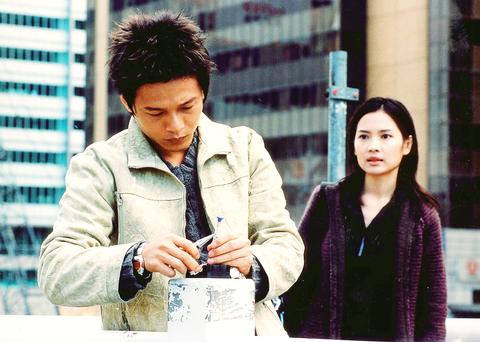
PHOTO: LEE MENG SAN
These movies have placed Tsai alongside Hou Hsiao-hsien (侯孝賢), Ang Lee and Edward Yang (楊德昌) to make up the pantheon of Taiwanese master filmmakers.
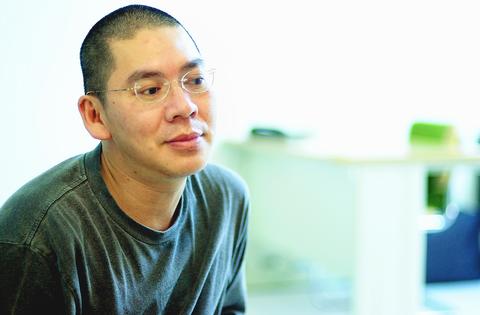
PHOTO: CHEN CHENG-CHANG, TAIPEI TIMES
Often labeled the Taiwanese version of French New Wave cinema, or minimalist cinema, Tsai's films nonetheless exude an entirely unique style -- the subtle movements between the characters, the sparse dialogue, the simple but precise camera blocking that creates sharp views and breath-taking dramatic effects.
"I write a story because I had a feeling and learned something about life. Like Francois Truffaut said, `filmmaking is life.' Whenever I want to see or observe human emotions, I will start shooting and see what happens," said Tsai, lounging at his office outside Taipei last week during an interview with Taipei Times.
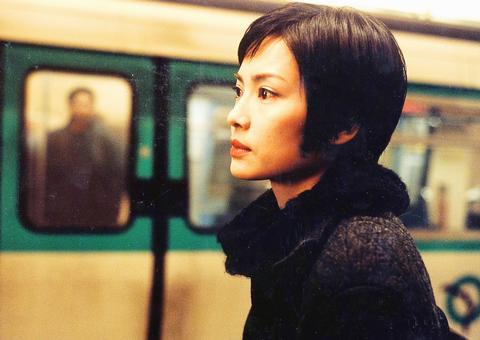
PHOTO: LEE MENG SAN
So what kind of revelation on life does What Time Is It There? provide? "It's a story about time and space, about the time difference between Taipei and Paris, about the distance between this world and the beyond. And it's about a man and a woman in Taipei and Paris, who, for some strange reason, miss each other," Tsai said. "But ultimately I wanted to talk about fear, the fear of death."
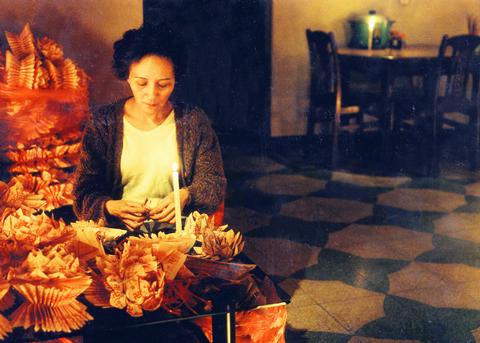
PHOTO: LEE MENG SAN
The story involves the life of Lee Kang-sheng (李康生), nicknamed Hsiao-kang (小康), who appears in each of Tsai's films. After the death of his father, Hsiao-kang, a watch vendor, becomes scared of the dark to the point that he will not go to the bathroom at night for fear he will see his father's ghost.
He meets Shiang-chih (湘琪) in Taipei, a young woman on her way to Paris. Shiang-chih took the watch Hsiao-kang had worn during the weeks following his father's death. After Shiang-chih took the watch, Hsiao-kang grows to miss the girl and develops an obsession with the seven-hour time difference between Taipei and Paris. He then tries to switch every clock he sees in Taipei by seven hours, so that they follow Paris time. Hsiao-kang's mother, for her part, develops an obsession with her husband's ghost returning to their house, and holds a series of folk religious rituals. Meanwhile in Paris, Shiang-chih engages in a sexual relationship with a woman she doesn't know.
Far from the typical romantic Paris of so many other movies, the city of lights is shot to look like a creepy ghost town. But Tsai says he did not do so to convey a sense of a spooky city. "It's not a horror movie! I did not try to create any horrific atmosphere. The scenes were all shot with a plain, realistic lens. The fear is not in the space, or environment, it's in people's heads, in their behavior."
Despite all of Tsai's awards and acclaim, especially in France, where he shares equal fame with Hou Hsiao-hsien, his films do poorly at Taiwan's box offices, which makes fundraising at home difficult. Some have said the homosexual content of some scenes in his films caused controversy for the Malaysian-born director. This may help explain in part why he hasn't released a film in three years since The Hole.
What Time Is It There? received most of its funding from the French film company Arena Film. With a budget of nearly US$3 million -- far more than the budgets of Tsai's previous works -- he said he had the latitude to make a film truer to his original conception.
He recruited noted cinematographer Benoit Delhomme, who helped on French-Vietnamese director Tran Anh Hung's (陳英雄) Cyclo and The Scent of Green Papaya, and Tim Yip (葉錦添), this year's Oscar winner for art direction for Crouching Tiger Hidden Dragon.
"In terms of technical quality, this film is by far the best among the works I've ever made," Tsai boasted. "You won't see the dark, pixelated images often seen in so-called Taiwanese art house films. And you won't have the bad sound common in Taiwanese films. Some of the post-production work was also done in France," Tsai said, including printing and light/color adjustment.
Tsai also cut in several classic images from Truffaut's 400 Blows to show Hsiao-kang's attempts to become familiar with the foreign environment of Paris and escape his fear of ghosts.
"Paris in the film is like another space that the characters tend to think is so different from Taipei. But in my film I attempted to make the Paris scenes look very similar to scenes one might see in Taipei. When you see it you feel like you're in Taipei," Tsai said.
"Truffaut remains my favorite director, so the film has a bit of sense of paying homage to him," Tsai said, adding that his film's title was changed from Seven to 400 Blows (七到四百擊).
French actor Jean-Pierre Leaud, the protagonist from 400 Blows even makes a cameo appearance in the film. "Years passed, the cute little boy in 400 Blows has gone through the vicissitudes of life and become a man with wrinkles," said Tsai of Leaud. "You see, this is the magic of film. You keep a person's youth on celluloid, but in my film, you see the great changes."
Tsai insists his film is not a bleak, intellectual art house piece that would look to overwhelm its viewers with thematic complexity, nor is it an attempt to make a clear and defined break from Hollywood. "I would not label films as art house or commercial. At the end of the day, you have to tell your own story with your own sense of the world," he said.
"I once told an investor that I would make a romance film out of What Time Is It There? just to get more funds. But during the shooting process, I was ultimately driven by my own feelings and dropped the romance scenes."
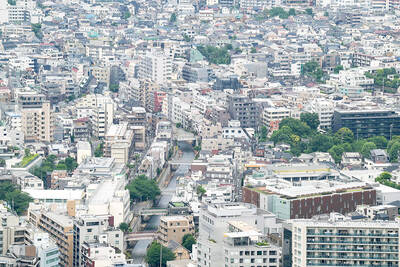
The canonical shot of an East Asian city is a night skyline studded with towering apartment and office buildings, bright with neon and plastic signage, a landscape of energy and modernity. Another classic image is the same city seen from above, in which identical apartment towers march across the city, spilling out over nearby geography, like stylized soldiers colonizing new territory in a board game. Densely populated dynamic conurbations of money, technological innovation and convenience, it is hard to see the cities of East Asia as what they truly are: necropolises. Why is this? The East Asian development model, with
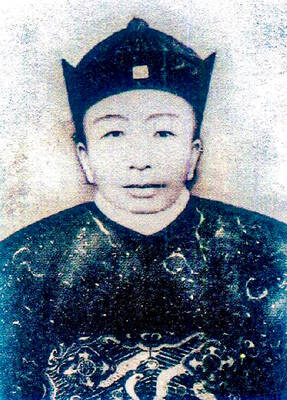
June 16 to June 22 The following flyer appeared on the streets of Hsinchu on June 12, 1895: “Taipei has already fallen to the Japanese barbarians, who have brought great misery to our land and people. We heard that the Japanese occupiers will tax our gardens, our houses, our bodies, and even our chickens, dogs, cows and pigs. They wear their hair wild, carve their teeth, tattoo their foreheads, wear strange clothes and speak a strange language. How can we be ruled by such people?” Posted by civilian militia leader Wu Tang-hsing (吳湯興), it was a call to arms to retake
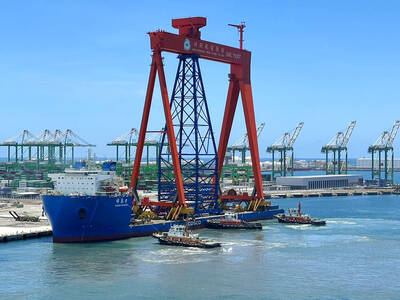
This is a deeply unsettling period in Taiwan. Uncertainties are everywhere while everyone waits for a small army of other shoes to drop on nearly every front. During challenging times, interesting political changes can happen, yet all three major political parties are beset with scandals, strife and self-inflicted wounds. As the ruling party, the Democratic Progressive Party (DPP) is held accountable for not only the challenges to the party, but also the nation. Taiwan is geopolitically and economically under threat. Domestically, the administration is under siege by the opposition-controlled legislature and growing discontent with what opponents characterize as arrogant, autocratic

When Lisa, 20, laces into her ultra-high heels for her shift at a strip club in Ukraine’s Kharkiv, she knows that aside from dancing, she will have to comfort traumatized soldiers. Since Russia’s 2022 invasion, exhausted troops are the main clientele of the Flash Dancers club in the center of the northeastern city, just 20 kilometers from Russian forces. For some customers, it provides an “escape” from the war, said Valerya Zavatska — a 25-year-old law graduate who runs the club with her mother, an ex-dancer. But many are not there just for the show. They “want to talk about what hurts,” she